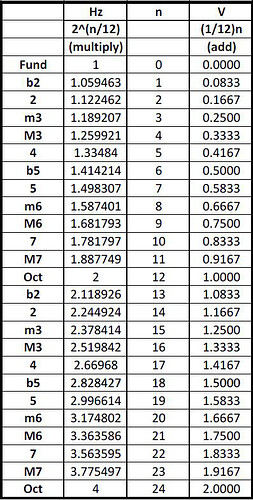So I’m using Nrmls to rise oscillators freq , though fm, an octave, which is 1volt. Anyhow, when I try to rise it any other number, for example 1.5, the pitch doesn’t matches that inteval even tho 1.5 is writen in V/oct on Nrmls. Same problem in any number that is not perfect octave. What would the convertion rate be from sonic interval to V/Oct?
Are you using linear FM or exponential FM? Linear is usually in tune, exponential is not. Other than that, you question would seem to answer itself. One octave is a volt. One semitone is 1/12 of a volt.
What Squinky said. If 1v is a C note then I’d expect 1.5v to give a note 6 semitones higher, a F#.
But nrmls squashes an input voltage to fit a voltage range so I’d double check the actual output voltage in one of the various cv utility modules. If you are looking to add pitches e.g. to boost something by a volt then you’d be better looking at a voltage adder.
Maybe try an offset generator like this one
Hey, you can use this as a reference:
But I prefer using VCV fade (or anything similar) to bend notes.
What is nrmls?
That Hz/v table is exponential and doesn’t work like the eurorack (and vcv rack) volt per octave system. It’s a different cv mapping as used by Korg. I guess you could ignore the Hz column and just look at n, but it’s confusing.
Cool. Thank you.
Yes ignore Hz and N. It’s just a table I made for my own uses. But the V column is the amount to ADD to get the musical interval you want. As you say, from C4, 1.5V will get you to an octave plus b5 or F#5.
I trust your word, if it is wrong I will delete it. I don’t wish to confuse anyone or give out wrong information.
(For what it’s worth the Hz column is what to multiply the fundamental frequency with to get the desired frequency, and has nothing to do with the V/Oct standard.)
Great. Seems Im using exponential then. Im using LFO multiphase which doesn’t seem to have an option to switch between Linear and Exponential What would be the formula to convert between linear and exponential?
Out of curiosity, what are you trying to rise the pitch to. If you say you are scaling it by 1.5, what pitch interval do you expect to get. Knowing this could help you solve your question.
I think they’ve fundamentally misunderstood how the Normaliser module works.
It spreads its voltage output based on the input voltage and the given range.
As it says in its user manual
Normaliser returns the input signal sent to in , scaled to a range from min to max . It keeps track of the lowest and highest values that so far have been sent to in , in two variables min_current and max_current . Mathematically, it returns (in - min_current ) / (max_current - min_current ) + min * (max -min ).
It absolutely isn’t a module for transposing an input note up or down a given number of semitones.
Yeah, I should have RTFM before commenting in this thread ![]() . I’m not familiar with Noobhour but trying it out now. Thanks!
. I’m not familiar with Noobhour but trying it out now. Thanks!
Bogaudio Stack?
1/12 v per semitone or 0.08333 volts
1/6 v for whole step or 0.1667
1/4v for m3 or 0.25 v
1/3v for M3 or 0.3333v
5/12v for P4 or 0.4167v
1/2 v for A4/D5 or .5v
7/12 v for P5 or .5833v
2/3v for m6 or . 666667v
3/4v for M6 or .75v
5/6v for m7 or .83333v
11/12v for Maj7 or .9167v
1v for octave hence the name Then it just repeats the above list with a 1 at beginning of each number until 2v etc.
Just like the above list, but I added intervals if that feels more musical to you. It’s good to think of your intervals as how many semitones they represent, like I know a 5th is 7 semitones.
I would use Little Utils Bias/Semitone. You can switch it to ‘semi’ and it adds/subtracts quantized semitones from -36 to +36
Yes!! Love that module.
so many modules, hadn’t heard of it but it sounds ideal. cheers
I haven’t heard of it too, I just checked the module browser for 10 minutes.
Thank You, although Im using this setup for exploring microtonal scales/making my own, so, semitones is not very useful in this context, as far as I’m aware of.
Good, thank you anyhow, Im working on creating my own microtonal scales so Im not so sure how this would be a practical module for that. I think it would add extra math/time/energy to the process by having to add substract to the standard scale versus just converting pitch to v/oct directly with formulae.

